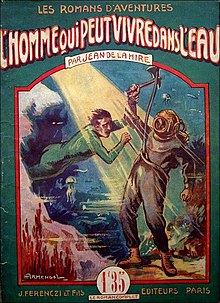|
Amphibian Man
Amphibian Man (rus. Человек-амфибия) is a science fiction adventure novel by the Soviet Russian writer Alexander Beliaev. It was published in 1928. PlotArgentinean doctor Salvator, a scientist and a maverick surgeon, gives his son, Ichthyander (Russian: Ихтиандр, Ikhtiandr) (Greek etymology: "Fish"+ "Man") a life-saving transplant - a set of shark gills. The experiment is a success but it limits the young man's ability to interact with the world outside his ocean environment. He has to spend much of his time in water. Pedro Zurita, a local pearl gatherer, learns about Ichthyander and tries to exploit the boy's superhuman diving abilities. Similar to other works by Beliaev, the book investigates the possibilities of physical survival under extreme conditions, as well as the moral integrity of scientific experiments. It also touches on socialist ideas of improving living conditions for the world's poor. Origins It is suggested the Belyayev borrowed the plot from the 1909 French novel The Man Who Can Live in Water by Jean de La Hire. (It was also serialized in the American newspapers under the title HICTANER The Man That Lived in the Water)[1] In the French novel a Jesuite villain Fulbert uses Hictaner, a man to whom scientist and surgeon Oxus transplanted shark's gills, to sink ships all over the globe to blackmail the world. But his plots were failed by Hictaner's love to Moisette. Belyayev could not read French, but this novel appeared in Russian at least twice. In 1909 the ultramonarchist newspaper Zemshchina published a remake in which the supevillain was a Jew. In 1911 the magazine Свет (Light) published the translation[2] of the French novel under the title Иктанэр и Моэзетта (Hictaner and Moisette).[3][4][5] AdaptationsThe 1962 film adaptation the Amphibian Man (Russian: Человеκ-aмфибия, translit. Chelovek-Amfibiya), was directed by Vladimir Chebotaryov. The film was the leader of Soviet distribution in 1962, with 65.5 million admissions during its initial run that year.[6] It later sold up to 100 million admissions including re-runs,[7] the highest for a Soviet film up until The Red Snowball Tree (1974).[8] Filmed on the South Coast of the Crimea and in Baku[9] and featuring a cast of beautiful young actors, the film features some popular song and dance numbers and has certain characteristics of a musical. The first song and the musical theme of the movie - "The song about the Sea Devil" became such a hit that it was sung well into the 1990s. A 2004 Russian TV series (4 episodes) The Amphibian Man. The Sea Devil (Человек-амфибия. Морской дьявол) was aired, loosely based on the novel and set in modern days.[10] TranslationsCultural influence
See alsoReferences
|